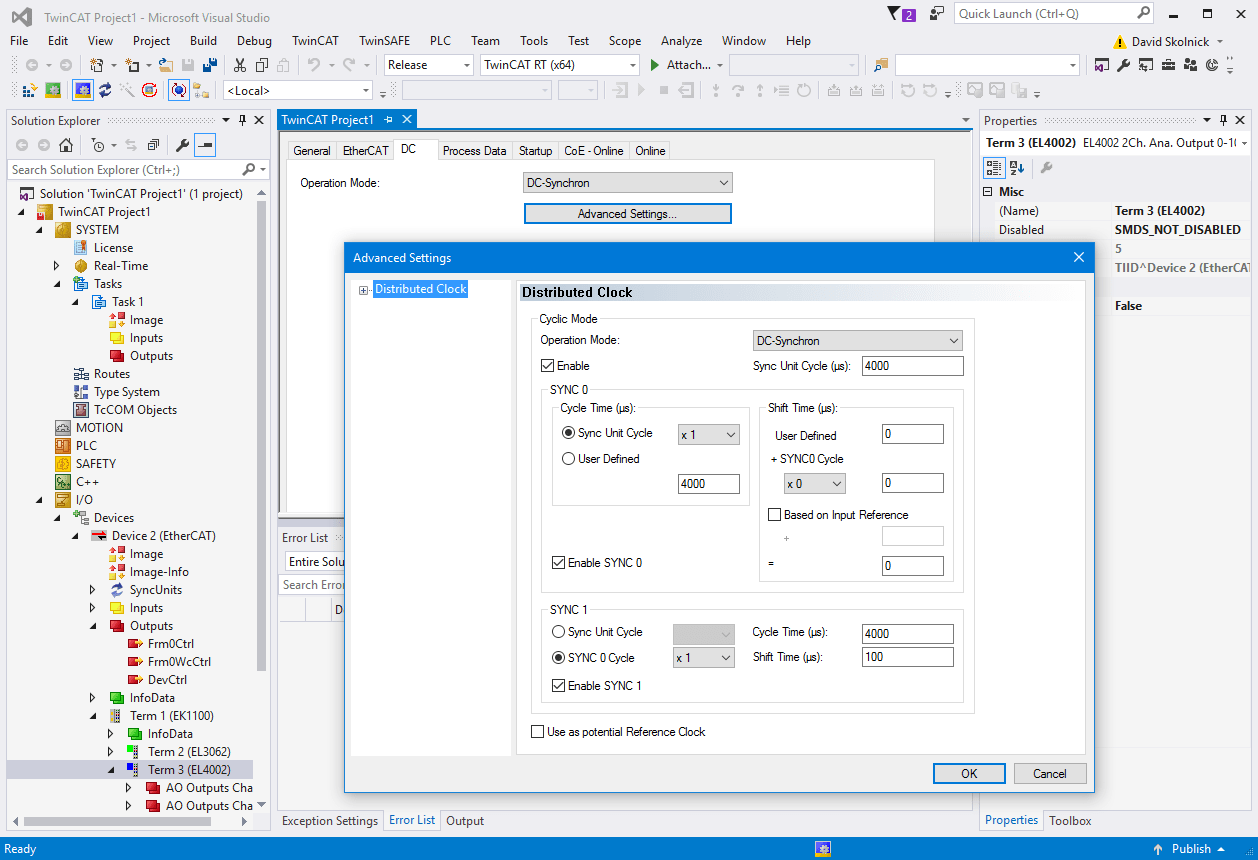EtherCAT Async SSC/SoE Download
Transmit data asynchronously to subordinate device represented by service data object
Libraries:
Simulink Real-Time /
EtherCAT
Description
The EtherCAT Async SSC/SoE Download block provides asynchronous SERCOS interface (SErial Real time COmmunication Specification) over EtherCAT® (SoE) download. The block selects an IDN in the specified subordinate device and sends a download (write) request. After sending the request, the block immediately continues processing its input data.
Examples
EtherCAT Protocol with Beckhoff Analog IO Subordinate Devices EL3062 and EL4002
Communicate with EtherCAT devices using the Beckhoff® analog I/O terminals EL3062 and EL4002.
EtherCAT Protocol with Beckhoff Digital IO Subordinate Devices EL1004 and EL2004
Communicate with EtherCAT devices using the Beckhoff digital I/O terminals EL1004 and EL2004.
EtherCAT Protocol Sequenced Writing SoE Subordinate Device Configuration Variables
Use SoE blocks and a simple state machine to write configuration values to variables that can only be written before going to EtherCAT Op state.
EtherCAT Protocol Sequenced Writing CoE Subordinate Device Configuration Variables
Use CoE blocks and a simple state machine to write configuration values to variables that can only be written before going to EtherCAT Op state.
EtherCAT Protocol Detect Network Failure and Reset
Use the EtherCAT Notifications block to detect a failure in the connected network and to restart the network when the failure is corrected.
EtherCAT Protocol Motor Velocity Control with Accelnet Drive
Control the velocity of a motor by using EtherCAT communication.
EtherCAT Protocol Motor Position Control with Accelnet Drive
Control the position of a motor by using EtherCAT communication.
Generate ENI Files for EtherCAT Devices
Generate EtherCAT network information (ENI) files to use in Simulink® Real-Time™ with EtherCAT devices.
Ports
Input
Input data for writing to the EtherCAT subordinate device. The data signal has the type specified in Data Type and vector dimension given by Dimension.
The Enable input is level sensitive and the block remains enabled while the input is non-zero. To send a value just once, you can enable the block with a single sample time pulse. There is a lag of approximately three cycles after the pulse for the data to send.
A value 0 disables downloads. A value greater than or equal to
1 enables the block to download data.
Output
Status of asynchronous data transfer:
0— Mailbox transfer object idle, transfer not running1— Mailbox transfer object running, transfer not complete2— Transfer successfully executed3— Error occurred during transfer request
If no error occurs, this port transmits
0. Otherwise, it transmits a
nonzero value. For list of error codes, see EtherCAT Error Codes.
Parameters
Identify parameters.
The documentation for your EtherCAT device specifies the IDN
values. You can select the IDN as a character vector that
represents a 16-bit integer (according to IEC 61800 -7 -204), such as
S-0-0150 or P-0-0150 with:
First field (bit 15):
Sfor Standard data,Pfor product-specific dataSecond field (bit 14 - 12):
0..7for parameter setThird field (bit 11 - 0):
0..4095for data-block number
Programmatic Use
Block Parameter:
idn |
Specify the decimal index of the drive.
SoE blocks apply to only motor controllers. A single subordinate device can support one or more drive or motor channels. The drive number is the zero-based index of the drive or motor channel on this subordinate device at which this block is aimed. In SoE terminology, the drive is the logic that sends control signals to the motor. Typically, this logic is a small processor inside the subordinate device.
Programmatic Use
Block Parameter:
drive |
To identify the data type for the IDN, refer to the subordinate device documentation for the description of the IDN and the data type it uses. From the list, select the data type of the IDN.
If you select a data type that does not match the type of the entry, the block returns
a nonzero value through the Error output.
Programmatic Use
Block Parameter:
sig_type |
Specify the row dimension of data for this IDN.
To identify the dimension of data (vector size) for the IDN, refer to the subordinate device documentation for the description of the IDN and the number of data type values (the dimension) it uses. Enter the vector length as found in the SoE description for the subordinate device in its manual.
Programmatic Use
Block Parameter:
sig_dim |
To associate a block with an EtherCAT network, enter the Network Device Index value from the EtherCAT Init block representing that network into the Network Device Index for the block.
Programmatic Use
Block Parameter:
device_id |
From the list, select the name of the device that contains the IDN.
The block populates this drop-down list with the contents of the configuration file.
Programmatic Use
Block Parameter:
subdevice_name |
Enter the base sample time or a multiple of the base sample time. -1 means
that sample time is inherited.
Programmatic Use
Block Parameter:
sample_time |
Enter the maximum number of milliseconds to wait for a response from the EtherCAT subordinate device.
Programmatic Use
Block Parameter:
timeout |
Extended Capabilities
C/C++ Code Generation
Generate C and C++ code using Simulink® Coder™.
Version History
Introduced in R2020b
MATLAB Command
You clicked a link that corresponds to this MATLAB command:
Run the command by entering it in the MATLAB Command Window. Web browsers do not support MATLAB commands.
Select a Web Site
Choose a web site to get translated content where available and see local events and offers. Based on your location, we recommend that you select: .
You can also select a web site from the following list
How to Get Best Site Performance
Select the China site (in Chinese or English) for best site performance. Other MathWorks country sites are not optimized for visits from your location.
Americas
- América Latina (Español)
- Canada (English)
- United States (English)
Europe
- Belgium (English)
- Denmark (English)
- Deutschland (Deutsch)
- España (Español)
- Finland (English)
- France (Français)
- Ireland (English)
- Italia (Italiano)
- Luxembourg (English)
- Netherlands (English)
- Norway (English)
- Österreich (Deutsch)
- Portugal (English)
- Sweden (English)
- Switzerland
- United Kingdom (English)







